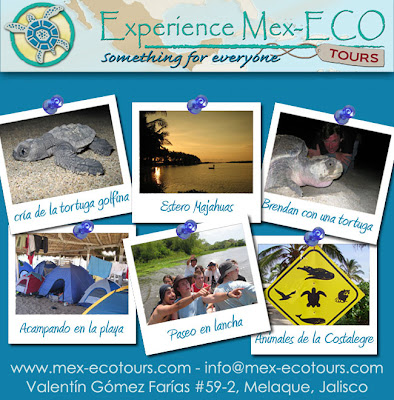This tour is provided by
Sea to Sierra based in Barra de Navidad
Some photos of the Plantation horseback riding tours Sea to Sierra with experienced horsemen Horacio and Ariel, two cousins from Aguacate, have been offering this season. The Plantation tour is a 2.5 hour ride for $500 pesos and everyone who's taken it has commented on how well trained the horses are and what a pleasurable experience it has been. We make sure you are comfortable too, adjusting the stirrups and making sure that we match you up with a horse that suits your abilities.

Having the stirrups adjusted for the ride, it takes a bit of time because they are attached with a leather thong not a buckle but the comfort gained makes it worthwhile and we don't mind taking the time.

Ariel also checks the rest of the tack prior to setting out.

It's a good idea to bring along sunglasses, a camera and a hat. These people were from Kamloops and Calgary and they had cowboy hats which fit with the tour really well, but any sun hat will do.

Guides Ariel (in front) Horacio (behind him) setting out from the coral in Aguacate...

and the tour clients on their mounts following behind.

View along the route.
Starting in Aguacate we ride through the plantations, orchards, farms and wilderness behind the little farming and ranching communities of Aguacate and Jaluco. Horacio is completely fluent in English and will answer any questions you may have on the ride.

Riding through a narrow trail, Ariel weilds a mean machete on the brush.

View overlooking Aguacate and Jaluco from the top of the hill.

Riding along one of the farm roads.

Riding a trail that runs through palm, banana and mango orchards in Aguacate.
We now have another new horseback riding tour available that runs from Aguacate, along Arroyo Seco under the highway around the back of Laguna Navidad, then over to Playa de Cocos on Isla Navidad and back. This is a 5 to 6 hour tour at a cost of $950 pesos per person. While the Playa de Cocos ride is not technically difficult non-riders may find it a lot of time in the saddle and prefer to opt for the shorter plantation ride.
If anyone is interested in more information about either of these horseback riding tours drop by our store at Veracruz 204 in Barra de Navidad, we are right across from the newly remodeled Jardin (town square). We are now open from 9 am to 2:00 pm and from 5 pm to 7 pm Monday through Friday, 10 to 2 on Saturdays and 10 to noon on Sundays. Or give us a call at the Office: 355-5790 or the House: 355-8582, or my cell 044-315-100-0282. All three numbers have voice mail if you don't happen to reach us leave us a message.
Villa Purificacion Plaza
Villa Purificacion government offices
Villa Purificacion street








 Having the stirrups adjusted for the ride, it takes a bit of time because they are attached with a leather thong not a buckle but the comfort gained makes it worthwhile and we don't mind taking the time.
Having the stirrups adjusted for the ride, it takes a bit of time because they are attached with a leather thong not a buckle but the comfort gained makes it worthwhile and we don't mind taking the time. Ariel also checks the rest of the tack prior to setting out.
Ariel also checks the rest of the tack prior to setting out. It's a good idea to bring along sunglasses, a camera and a hat. These people were from Kamloops and Calgary and they had cowboy hats which fit with the tour really well, but any sun hat will do.
It's a good idea to bring along sunglasses, a camera and a hat. These people were from Kamloops and Calgary and they had cowboy hats which fit with the tour really well, but any sun hat will do. Guides Ariel (in front) Horacio (behind him) setting out from the coral in Aguacate...
Guides Ariel (in front) Horacio (behind him) setting out from the coral in Aguacate... and the tour clients on their mounts following behind.
and the tour clients on their mounts following behind. View along the route.
View along the route. Riding through a narrow trail, Ariel weilds a mean machete on the brush.
Riding through a narrow trail, Ariel weilds a mean machete on the brush. View overlooking Aguacate and Jaluco from the top of the hill.
View overlooking Aguacate and Jaluco from the top of the hill. Riding along one of the farm roads.
Riding along one of the farm roads. Riding a trail that runs through palm, banana and mango orchards in Aguacate.
Riding a trail that runs through palm, banana and mango orchards in Aguacate.







